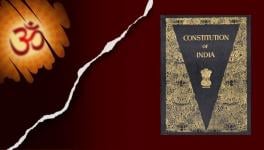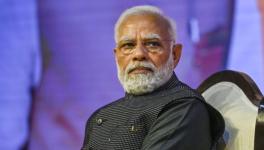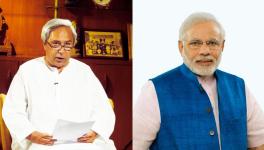How BJP Covers Betrayals in Glory

The tomb of Nawab Siraj-ud-Daulah. Image credit: Wikimedia Commons
Elections to the 18th Lok Sabha have broken records in many ways.
Right from the arrests of Opposition leaders on the eve of elections, the spinelessness shown by the Election Commission (EC) to the open mouthing of hateful speeches targeting a community by top members of the ruling dispensation, to complete metamorphosis of the mainstream media into a cheerleader of the government, all such signs are ominous for the future of democracy in the country.
May be one should add to it the open justification by ruling Bharatiya Janata Party (BJP) leaders of the betrayal by the likes of Mir Jafar and his associates like Raja Krishnachandra Roy, Jagat Seth, Omi Chand -- which lead to defeat of the Siraj-ud-Daulah (1733-July 2,1757), the last independent Nawab of Bengal in the Battle of Plassey, which ultimately opened the gates of conquest of the rest of India by the Britishers.
If 2019 elections are still remembered because BJP had fielded candidates who were accused of involved in terrorist acts, the 2024 elections would also be remembered how they helped betrayals covered in glory.
It is noteworthy that Amrita Roy, popularly known as Rani Maa, a BJP candidate in the Krishnanagar constituency of West Bengal, is literally making waves with her controversial utterances.
Râni Maa happens to be wife of a descendant of Raja Krishna Chandra Roy, an associate of Mir Jafar.
Her claim that the defeat of Siraj-ud-Daulah was necessary to save 'Sanatan Dharm' has created a sense of unease even among BJP's hard-core workers.
The Battle of Plassey and the ultimate victory of the British over India has so overshadowed our conversations, that the way the young dynamic ruler Siraj-ud-Daulah -- who was executed by Mir Maran, son of Mir Jafar, after the fall of Plassey, who was made Nawab of Bengal by the Britishers for a while (July 2, 1757) -- tried to combat the East India Company, has not received the attention he deserves.
One learns that his reign extended to Bengal, Bihar as well as Orissa. At a very young age, Siraj-ud-Daulah had well understood the machinations of the East India Company and even attacked Fort William in Calcutta, a headquarter of the Company and captured it. He had also tried to establish contact with the French East India Company, who had established a colony at Chadan Nagar, on the banks of river Hooghly. It is a different matter that the Britishers proved smarter, who did not let the French expand their influence in the region.
Till date the 'martyrdom' of Siraj-ud-Daulah is still remembered and he is revered by people.
And the collective memory of the betrayal by Mir Jafar and his associates, like Raja Krishnachandra Roy, is still alive in the minds of the people. Like Mir Jafar's descendants, the descendants of his co-conspirators, are still condemned and they are criticised for their support to the British
It is a common sight that when people visit the well- maintained mausoleum of Siraj-ud-Daulah in Murshidabad, they literally throw stones etc. at Mir Jafar's dilapidated mausoleum.
What is rather shocking is to know that BJP and its top leaders, including the Prime Minister, have not tried to rein in Rani Maa. Perhaps, they very well understand that it will help them further polarise the voters on religious grounds. In fact, they must have had their own designs in mind in choosing Amrita Roy as a candidate for this high-stakes battle.
The audio tapes of the conversation between Amrita Roy and Prime Minister Narendra Modi, has been widely circulated. One learns that Modi lauded the “legacy of Maharaja Krishna Chandra” and even told her that in his childhood, he was "[t]aught about Krishna Chandra Roy’s social reforms work and developmental work”.
The PM even tells her not to get discouraged by critics who call her 'traitors'.
There is nothing surprising or disturbing that BJP has no qualms even in providing legitimacy to 'traitors' like Mir Jafar or Raja Krishnachandra Roy and deriding and stigmatising Siraj-ud-Daulah, the last independent Nawab of Bengal
One knows very well how under the project of revising history, which has received fresh fillip with the ascent of Hindutva supremacism at the Centre, they are keen now to revise how Siraj-ud-Daulah is understood and presented. It is an integrated part of this project, which has today reached such ridiculous proportions that yesteryear heroes are being turned into villains and vice-versa.
This well thought out plan to stigmatise Siraj-ud-Daulah reminds one of the slow and conscious vilification of Tipu Sultan (November 20,1750 - May 4, 1799), the 'Tiger of Mysore', the only King in pre-British India who was 'martyred' on the battlefield fighting the British at the historic battle at Srirangpatnam, an event that preceded the revolt of the 1857 by 58 years. Not very many people know that he had even sacrificed his children in the war.
There are lot of commonalities between the lives of Siraj-ud-Daulah and Tipu Sultan.
Both very well understood the machinations of the East India Company and also tried to take help from the French against a 'common enemy', and both were betrayed by their close confidantes: Mir Jafar and Mir Sadiq, respectively.
If today Siraj-ud-Daulah is slowly being packaged and presented, rather constructed as a religious fanatic, obliterating his fight against British and his 'martyrdom', the Hindutva Supremacists have similarly packaged image of Tipu Sultan which is at much variance with his actual self.
A cursory glance at books and monographs tell us that Tipu was a ruler much ahead of his times, a scholar, soldier and poet, he was an apostle of Hindu-Muslim unity, was fond of inventions, and is called the ‘innovator of the world’s first war rocket,’ one who was inspired by the French Revolution and who despite being a ruler called himself a ‘citizen’. He had planted a tree of ‘Liberty’ in his palace.
As earlier mentioned, Tipu Sultan had sensed the designs of the British and tried to forge broader unity with domestic rulers and to connect with the French, the Turks and the Afghans to give a befitting reply to the British. He had defeated the British army twice with his superior planning and better techniques earlier.
An interesting episode in his eventful life that throws light on his character is worth emphasising. It was the year 1791, when Maratha army raided the Sringeri Shankaracharya mutt and temple, plundered the monastery of all its valuables and killed many. The incumbent Shankaracharya wrote to Tipu Sultan for help, who immediately ordered Asaf of Bednur to provide help to the mutt. Around 30 letters exchanged between Tipu Sultan and the Shankaracharya, written in Kannada, are available. The letters were discovered in 1916 by the Director of Archaeology in Mysore.
Expressing his indignation at the raid, Tipu wrote:
People who have sinned against such a holy place are sure to suffer the consequences of their misdeeds at no distant date in this Kali age in accordance with the verse: “Hasadbhih kriyate karma ru dadbhir-anubhuyate” (People do [evil] deeds smilingly but suffer the consequences crying). (-do-)
Whatever 'rewriting of history' the saffronites will do, it is for sure that the 'martyrdom'of Siraj-ud-Daulah, the young 24-year-old last independent Nawab of Bengal or that of Tipu Sultan -- who defeated the Britishers twice -- on the battlefield itself, will continue to inspire coming generations.
For a formation like the Rashtriya Swayamsevak Sangh (RSS) and its allied organisations, which kept away from the heroic anti-colonial struggle supposedly to concentrate on building organisation and were, in fact, engaged in breaking the broad unity of people cutting across faith and community lines against the Britishers, such moves to manufacture a biased view of Siraj-ud-Daulah or Tipu Sultan does not appear surprising.
Perhaps by attacking them, and presenting a distorted version of their legacy, the saffronites think that they will be able to avoid discussion on their not so glorious role in the anti-colonial struggle, how their top leaders like Hedgewar, one of the founder of RSS and Golwalkar, one of its chief ideologues, who shaped the organisation, asked/instructed RSS members not to participate in the anti-British campaigns/struggles.
Or how Vinayak Damodar Savarkar, who is held in high esteem by them, even went to the extent of asking Hindus to join the British-led military when on the one hand the Quit India movement was at its peak (1942), which had posed tremendous challenges before the Britishers
More about that later.
The writer is an independent journalist. The views are personal.
Get the latest reports & analysis with people's perspective on Protests, movements & deep analytical videos, discussions of the current affairs in your Telegram app. Subscribe to NewsClick's Telegram channel & get Real-Time updates on stories, as they get published on our website.
























